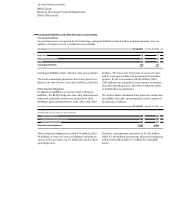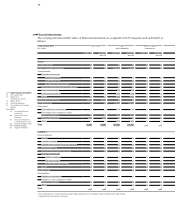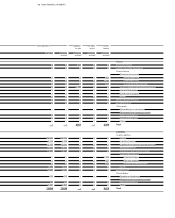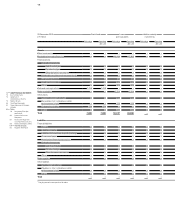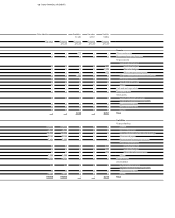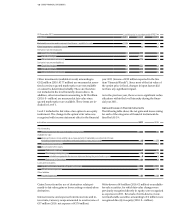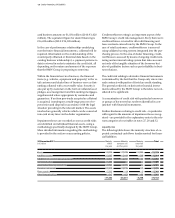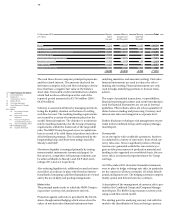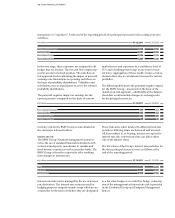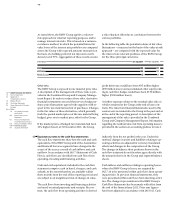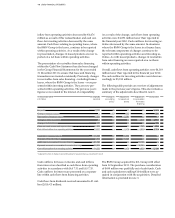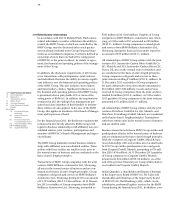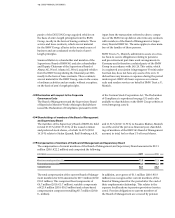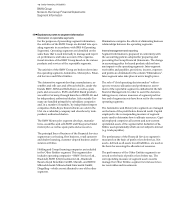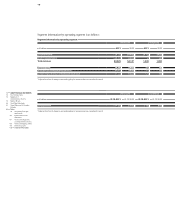BMW 2011 Annual Report Download - page 138
Download and view the complete annual report
Please find page 138 of the 2011 BMW annual report below. You can navigate through the pages in the report by either clicking on the pages listed below, or by using the keyword search tool below to find specific information within the annual report.
138
76 GROUP FINANCIAL STATEMENTS
76 Income Statements
76 Statement of
Comprehensive Income
78 Balance Sheets
80 Cash Flow Statements
82 Group Statement of Changes
in Equity
84 Notes
84 Accounting Principles
and Policies
100 Notes to the Income
Statement
107 Notes to the Statement
of Comprehensive Income
108
Notes to the Balance Sheet
129 Other Disclosures
145 Segment Information
The cash flows shown comprise principal repayments
and the related interest. The amounts disclosed for
derivatives comprise only cash flows relating to deriva-
tives that have a negative fair value at the balance
sheet date. Irrevocable credit commitments to dealers
which had not been called upon at the end of the
reported period amounted to € 5,764 million (2010:
€ 4,654 million).
Solvency is assured at all times by managing and moni-
toring the liquidity situation on the basis of a rolling
cash flow forecast. The resulting funding requirements
are secured by a variety of instruments placed on the
world’s financial markets. The objective is to minimise
risk by matching maturities for the Group’s financing
requirements within the framework of the target debt
ratio. The BMW Group has good access to capital mar-
kets as a result of its solid financial position and a diver-
sified refinancing strategy. This is underpinned by the
longstanding long- and short-term ratings issued by
Moody’s and S & P.
Short-term liquidity is managed primarily by issuing
money market instruments (commercial paper). In
this
area too, competitive refinancing conditions can
be
achieved thanks to Moody’s and S & P short-term
ratings of P-1 and A-2 respectively.
Also reducing liquidity risk, additional secured and unse-
cured lines of credit are in place with first-class interna-
tional banks. Intra-group cash flow fluctuations are evened
out by the use of daily cash pooling arrangements.
Market risks
The principal market risks to which the BMW Group is
exposed are currency risk and interest rate risk.
Protection against such risks is provided in the first in-
stance though natural hedging which arises when the
values of non-derivative financial instruments have
matching maturities and amounts (netting). Derivative
financial instruments are used to reduce the risk re-
maining after netting. Financial instruments are only
used to hedge underlying positions or forecast trans-
actions.
The scope of permitted transactions, responsibilities,
financial reporting procedures and control mechanisms
used for financial instruments are set out in internal
guidelines. This includes, above all, a clear separation of
duties between trading and processing. Currency and
interest rate risks are managed at a corporate level.
Further disclosures relating to risk management are pro-
vided in the Combined Group and Company Manage-
ment Report.
Currency risk
As an enterprise with worldwide operations, business
is conducted in a variety of currencies, from which cur-
rency risks arise. Since a significant portion of Group
revenues are generated outside the euro currency re-
gion and the procurement of production material and
funding is also organised on a worldwide basis, the cur-
rency risk is an extremely important factor for Group
earnings.
At 31 December 2011 derivative financial instruments
were in place to hedge exchange rate risks, in particular
for the currencies Chinese renminbi, US dollar, British
pound and Japanese yen. The hedging contracts comprise
mainly option and forward currency contracts.
A description of the management of currency risk is pro-
vided in the Combined Group and Company Manage-
ment Report. The BMW Group measures currency risk
using a cash-flow-at-risk model.
The starting point for analysing currency risk with this
model is the identification of forecast foreign currency
31 December 2010 Maturity Maturity Maturity Total
in € million within between one later than
one year and five years five years
Bonds – 7,812 – 19,567 – 3,197 – 30,576
Liabilities to banks – 3,594 – 4,029 – 587 – 8,210
Liabilities from customer deposits (banking) – 8,089 – 3,210 – 25 – 11,324
Commercial paper – 5,246 – – – 5,246
Asset backed financing transactions – 1,810 – 5,811 – – 7,621
Derivative instruments – 1,244 – 1,375 – 35 – 2,654
Trade payables – 4,327 – 24 – – 4,351
Other financial liabilities – 771 – 532 – 525 – 1,828
– 32,893 – 34,548 – 4,369 – 71,810



